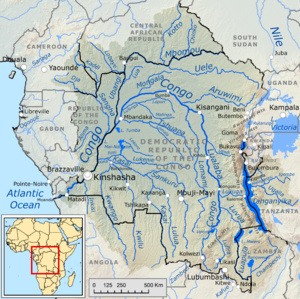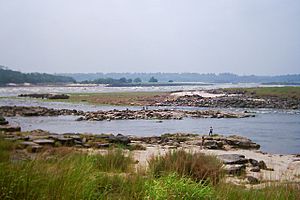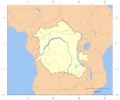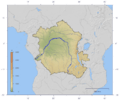Congo River facts for kids
Quick facts for kids Congo River |
|
|---|---|

The Congo River near Kisangani, Congo
|
|

The drainage basin of the Congo River
|
|
| Other name(s) | Zaire River |
| Physical characteristics | |
| Main source | Lualaba River Boyoma Falls 1,590 m (5,220 ft) |
| River mouth | Atlantic Ocean 06°04′27″S 12°26′59.99″E / 6.07417°S 12.4499972°E |
| Length | 4,700 km (2,900 mi) |
| Width |
|
| Depth |
|
| Basin features | |
| Basin size | 4,014,500 km2 (1,550,000 sq mi) |
| Tributaries | |
The Congo River is a huge river in Africa. It is also known as the Zaire River. It is the second longest river in Africa, right after the Nile. It is also the second largest river in the world by the amount of water it carries, only smaller than the Amazon River.
The Congo River is also the world's deepest river. Some parts are measured to be about 219.5 meters (720 feet) deep! If you include its longest branches, the Lualaba River and Chambeshi River, the whole system is about 4,700 kilometers (2,920 miles) long. This makes it the ninth longest river in the world.
The Congo River is special because it is the only major river that crosses the Equator twice. Its drainage basin (the area of land where all the water flows into the river) is about 4 million square kilometers (1.5 million square miles). This is about 13% of all the land in Africa!
The river gets its name from the old Kingdom of Kongo, which was located near its mouth. The countries of the Democratic Republic of the Congo and the Republic of the Congo are both named after this mighty river. They sit along its banks.
Contents
Where the Congo River Starts
The Congo River begins in the high lands and mountains of the East African Rift. Water from Lake Tanganyika and Lake Mweru also flows into the Lualaba River. The Lualaba River then becomes the Congo River after the Boyoma Falls.
The Chambeshi River in Zambia is usually seen as the true source of the Congo. This is because it is the longest branch, which is a common way to find a river's source, just like with the Nile River.
The River's Journey
From Kisangani, just below the Boyoma Falls, the Congo River flows mostly west. Then, it slowly turns southwest. It passes by Mbandaka and joins with the Ubangi River.
The river then flows into a wide area called the Pool Malebo (also known as Stanley Pool). The big cities of Kinshasa and Brazzaville are on opposite sides of the river at this pool. After the pool, the river gets narrower and flows through many waterfalls and deep canyons. These are known as the Livingstone Falls. The river then passes by Matadi and Boma before finally flowing into the Atlantic Ocean near the small town of Muanda.
Exploring the Congo River
Europeans first visited the mouth of the Congo River in 1482. This was the Portuguese explorer Diogo Cão. Later, in 1817, a British team led by James Hingston Tuckey explored the river up to Isangila.
However, Henry Morton Stanley was the first European to travel along the entire length of the Congo River. He made this amazing journey in the late 1800s.
Why the Congo River is Important
Even though the Livingstone Falls stop ships from coming in from the sea, most of the Congo River is good for boats in different parts. It is especially easy to travel by boat between Kinshasa and Kisangani.
Railways have been built around the three main waterfalls that block boats. This means that many goods from central Africa are moved along the river. Things like copper, palm oil, sugar, coffee, and cotton are transported this way.
The river is also very important for making hydroelectric power. Large dams, like the Inga Dams, have been built below Pool Malebo to create electricity.
In 2005, a power company from South Africa, called Eskom, suggested a plan to make even more electricity from the Inga Dams. They wanted to improve the existing dams and build a new one. This project could make the dam's power output reach 40 gigawatts (GW). That's twice as much as China's huge Three Gorges Dam!
Nature and Wildlife

The Congo River as we know it today was formed between 1.5 and 2 million years ago. This was during a time called the Pleistocene Ice Age. During this period, many smaller rivers that used to flow into other river systems were "captured" by the Congo. This means their water started flowing into the Congo River instead.
The formation of the Congo River might have even helped create new animal species. For example, it is thought that the river separated the ancestors of the bonobo and the common chimpanzee. The bonobo is a type of ape that lives only in the humid forests of this region. Other unique animals found here include the Allen's swamp monkey, dryas monkey, aquatic genet, okapi, and Congo peafowl.
Amazing Aquatic Life
The Congo River Basin is home to a huge variety of water animals. It has one of the highest numbers of unique species found nowhere else in the world. As of 2009, nearly 800 different kinds of fish have been found in the Congo River Basin. And many parts of the river still haven't been fully studied! New fish species are still being discovered regularly.
The Congo River system has much more fish diversity than any other African river. For example, the Niger River has about 240 fish species, and the Nile has about 130.
Because the Congo Basin has so many different types of places – like fast-flowing rapids, deep rivers, swamps, and lakes – it is often divided into many different ecoregions. For instance, the Livingstone Falls area alone has over 300 fish species, and about 80 of them are found only there.
Some of the most common fish families in the river include Cyprinidae (like carp), Mormyridae (elephant fishes), Alestidae (African tetras), Mochokidae (squeaker catfishes), and Cichlidae (cichlids). One amazing native fish is the huge, meat-eating giant tigerfish.
There are also some very unusual fish found only in the Congo. One is the whitish and blind Lamprologus lethops, which is thought to live as deep as 160 meters (525 feet) below the surface. Another is Heterochromis multidens, which is more closely related to cichlids from the Americas than other African cichlids. And Caecobarbus geertsii is the only known cavefish in Central Africa.
Sadly, several new hydroelectric dams are planned for the river. These dams could cause many of these unique species to disappear forever.
Besides fish, many unique frogs and snails live in the Congo River. Several types of turtles also live here, along with the slender-snouted, Nile, and dwarf crocodile. African manatees can be found in the lower parts of the river.
Main Branches of the Congo River
Here are some of the important rivers that flow into the Congo, listed from the mouth of the river upstream:
- Inkisi
- Nzadi
- Nsele (on the south side of Pool Malebo)
- Bombo
- Kasai
- Fimi
- Lukenie
- Kwango
- Sankuru
- Likouala
- Sangha
- Ubangi
- Giri
- Uele
- Mbomou
- Luvua
- Luapula
Images for kids
See also
 In Spanish: Río Congo para niños
In Spanish: Río Congo para niños








